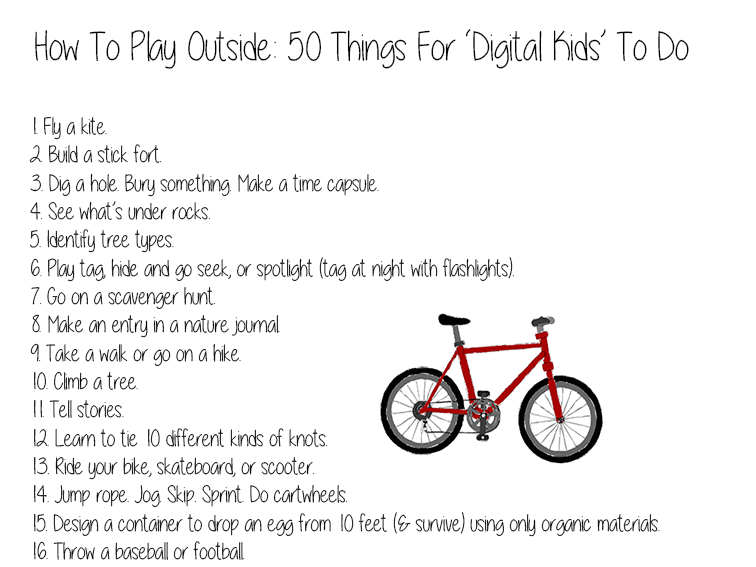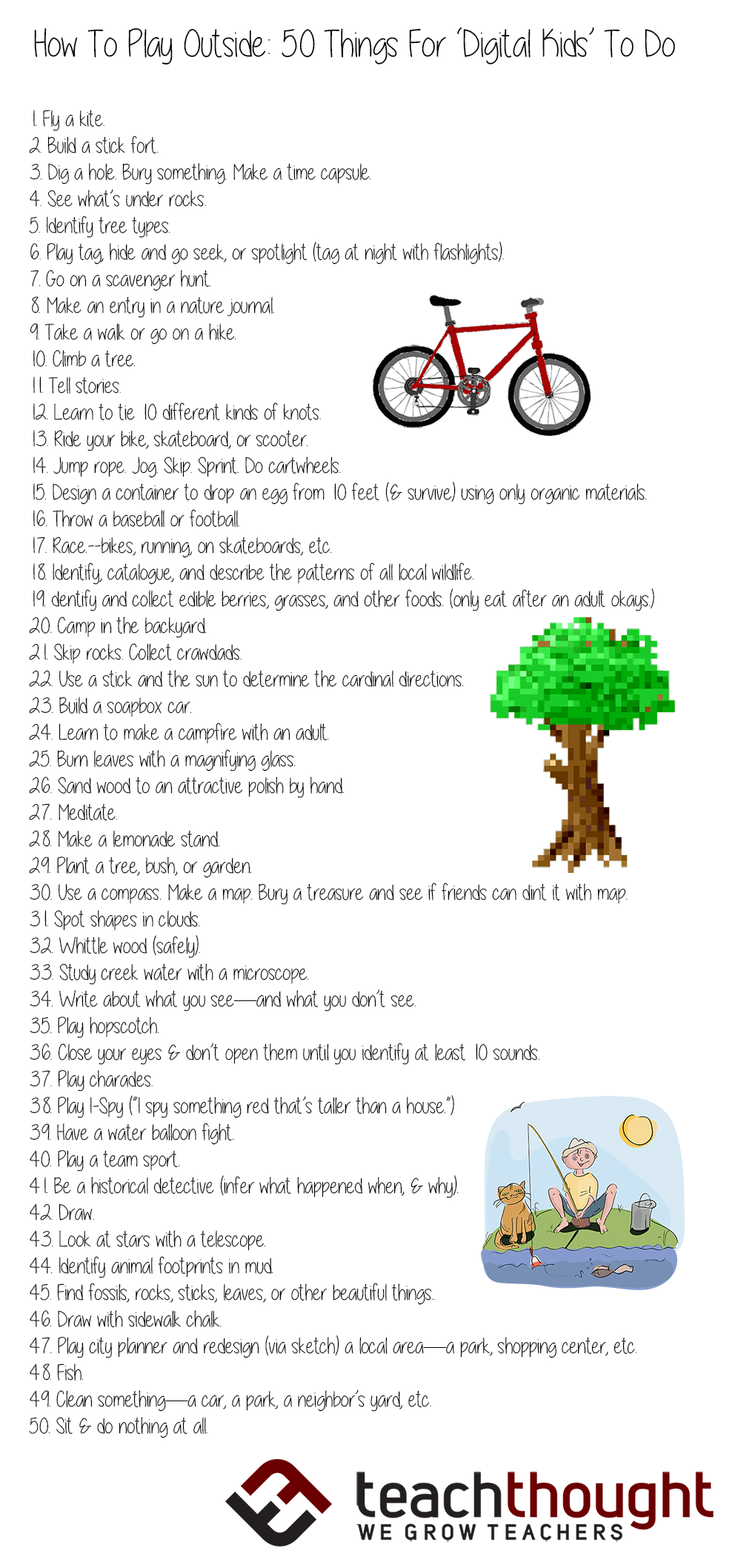
How To Play Outside: 50 Things For ‘Digital Kids’ To Do
by Terry Heick
So you’ve been told to go outside, and you’re not sure what to do.
Of course, you’re not happy about it. There’s no electricity outside, no Wi-Fi, and the sun’s glare on your iPad screen is just plain awful.
You remember going outside before, but can’t recall much beyond moving from the house to the car to the store back to the car and in the house again—a familiar pattern.
Either way, you are quite sure that being outside sucks. After all, your parents get to stay inside—why should you have to go outside? There’s nothing to do, and you’ll be bored. Note that your failures at playing outside are our failures as parents and teachers, so we’re going to address this together.
Have a seat.
Getting Ready
Before you open the door, shield your eyes with your forearm; the sun (that large, hot ball of fire in the sky) is bright. But more on the sun later—just shield your eyes and walk outside. You may notice everything is quite different—more spacious, different sounds, no touchscreen.
You interact with ‘outside’ different than a computer or tablet—multitasking here is a matter of walking and talking, or throwing a baseball and laughing. There are no download times, no notifications bars, and when people want you, they yell your name and make eye contact with you. (This can be unsettling at first, but you’ll get used to it). Be prepared for the jarring change from a structured and me-centered indoors, to an outdoors that isn’t ‘user-centered.’
(Seriously, don’t make me lock the door; I will and the courts will be on my side.)
See also Shifting The Focus From Ideas To The Effects Of Those Ideas
Observe Nature
Now that you’re outside and your eyes have adjusted to the light, note how the closer you get to the trees and flowers, the more they rival the retina display of your iPad.
This is not by accident–your iPad is designed to replicate real-life–stuff like tree bark, sunsets, and human faces. Resist the urge to take a TikTok video—just keep walking, and paying careful attention to the world around you that’s been here for 4 billion years longer than your smartphone. Don’t worry about ‘what to do.’ Just observe.
If you’re feeling crazy, rebellious, and simply out of control, take off your shoes and walk barefoot in the grass. Feels weird doesn’t it? Kind of tickles your feet? Feels good between your toes? Terrific. Just walk around a little in it–maybe lay down on your back and look up at the clouds. Spot something you’ve never seen before–imagine the sky as one giant wallpaper for your iPad, pinch and zoom clouds and everything.
(No, seriously–if you do this last part and admit it, I’m locking you outside and you’re not coming back in.)
Beginning to Interact
Your next step is to find other humans and see what they’re doing. Note that you won’t see any colorful avatars or duck faces outside (well, other than an actual duck’s face). Everything here is real, enduring, and sage. The bright yellow star in the sky? That’s the sun. Keep track of it. It can burn you in the summer, and it gets dark when it starts to set. It may also make you feel joy if you close your eyes and turn your face in its direction.
Careful.
And when it starts to set and spills light paint over the edge of the world without an instagram filter, just know this happens almost every night. Maybe a reminder on your phone to check it out from time to time?
Knocking on doors.
You may want to interact with others, and to do so without a text or DM and might require you to knock on a door and ask if so-and-so can come out to play. (Yes, teenagers can knock on doors, too.)
Knocking etiquette is simple—knock your fist on the door at a moderately loud but not obnoxious level 3 or 4 times, then wait. If no one comes to the door within 30 seconds, try one more time—or a doorbell, and wait again. It could be that no one is home, but without a GPS chip in their neck, it’s hard to know for sure. You may be on your own for a bit.
If they do answer? Ask if they want to play. That’s it.
As for what you should do, we’ll get to those ideas in a bit. For now, just notice that houses and hills and trees aren’t shaped like blocks as they are in Minecraft. You don’t get XP and level up for completing tasks, and there is no constant stream of news to make you feel connected. These are not glitches.
What are you ‘supposed to do’ without clear goals, targets, and objectives? This is your life’s work, child.
Other Factors
As you play, note that exertion can cause you to sweat on warmer days. These little wet spots on your forehead are perfectly normal, and will go away when you wipe them or reduce the exertion. Don’t be alarmed.
And note that without Google, you may have to survive without knowing something the second you want to know it. You’ll (probably) live.
Stopping Play
Knowing when to stop your play is a very personal thing.
If you have to use the restroom, stop playing and go use it.
If you’re hungry, you can grab a sandwich and go back outside to play.
Eventually, your friend may have to go home, or it may begin to get dark. This means your time outside is drawing to a close, but note that you don’t necessarily have to go inside just because it’s dark. Just stick a bit closer to home—maybe tag in the front yard, or collect lightning bugs in a jar (though they make your hands stink—wash your hands before you touch your phone).
Still stumped? Here are 50 ideas.

How To Play Outside: 50 Things For ‘Digital Kids’ To Do
- Fly a kite.
- Build a stick fort.
- Dig a hole. Bury something. Make a time capsule.
- See what’s under rocks.
- Identify tree types.
- Play tag, hide and go seek, or spotlight (tag at night with flashlights).
- Go on a scavenger hunt.
- Make an entry in a nature journal.
- Take a walk or go on a hike.
- Climb a tree.
- Tell stories.
- Learn to tie 10 different kinds of knots.
- Ride your bike, skateboard, or scooter.
- Jump rope.
- Design a container to drop an egg from 10 feet (and survive) using only organic materials.
- Throw a baseball or football.
- Race.
- Identify, catalogue, and describe the patterns of all local wildlife.
- Identify and collect edible berries, grasses, and other foods. (Only eat after an adult okays.)
- Camp in the backyard.
- Skip rocks.
- Use a stick and the sun to determine the cardinal directions.
- Build a soapbox car.
- Learn to make a campfire with an adult.
- Burn leaves with a magnifying glass.
- Sand wood to an attractive polish by hand.
- Meditate.
- Make a lemonade stand.
- Plant a tree, bush, or garden.
- Use a compass.
- Spot shapes in clouds.
- Whittle (safely).
- Study creek water with a microscope.
- Write about what you see—and what you don’t see.
- Play hopscotch.
- Close your eyes and don’t open them until you identify at least 10 sounds.
- Play charades.
- Play I-Spy (“I spy something red that’s taller than a house.”)
- Have a water balloon fight.
- Play a team sport.
- Be a historical detective (infer what happened when, and why).
- Draw.
- Look at stars with a telescope.
- Identify animal footprints in the mud.
- Find fossils.
- Draw with sidewalk chalk.
- Play city planner and redesign (via sketch) a local area—a park, shopping center, etc.
- Fish.
- Clean something—a car, a park, a neighbor’s yard, etc.
- Sit and do nothing at all.
Image attribution flickr users johntrainor, roxijc, markiverson, and pennuja